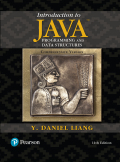
(Revising Listing 19.1) Revise the GenericStack class in Listing 19.1 to implement it using an array rather than an ArrayList. You should check the array size before adding a new element to the stack. If the array is full, create a new array that doubles the current array size and copy the elements front the current array to the new array.
Revising Listing 19.1
Program Plan:
- Define the class named “GenericStack<E>”.
- Declare appropriate variables to program.
- Define constructors “GenericStack()” which assigns initial size of stack and “GenericStack(initialCapaciy)” which assigns size of the stack.
- Define a method “push()” which pass “E o” as parameter.
- Using “if” condition, check the value of “N” greater than “elements.length”.
- Assign size of new array.
- Copy old array into new array.
- Return array elements.
- Using “if” condition, check the value of “N” greater than “elements.length”.
- Define a method “pop()” which pop out stack elements.
- Return array elements.
- Define a method “peek()” which returns top of the stack.
- Define a method “isEmpty()” which returns “0”.
- Define a method “getSize()” which returns size of the stack.
- Define the main method.
- Declare the GenericStack object “obj”, using the object insert elements into stack.
- Using “while” loop, print the elements on screen.
The following JAVA code is to revise the “GenericStack” class which implements array rather than an “ArrayList”.
Explanation of Solution
Program:
//Class definition
class GenericStack<E>
{
/*Declaration of variables*/
public final static int INITIAL_SIZE = 16;
private E[] elements;
private int N;
/*Construct a stack with the default initial capacity */
public GenericStack()
{
//Assign initial size
this(INITIAL_SIZE);
}
/*Construct a stack with the specified initial capacity */
public GenericStack(int initialCapacity)
{
//Assign size
elements = (E[])new Object[initialCapacity];
}
/*Push a new element into the top of the stack */
public E push(E o)
{
//Condition
if (N >= elements.length)
{
//Assign array size into variable "t"
E[] t = (E[])new Object[elements.length * 2];
//Copy array elements
System.arraycopy(elements, 0, t, 0, elements.length);
//Assign "t" into "elements"
elements = t;
}
//Return statement
return elements[N++] = o;
}
/*Return and remove the top element from the stack*/
public E pop()
{
//Return statement
return elements[--N];
}
/*Return the top element from the stack */
public E peek()
{
//Return statement
return elements[N - 1];
}
/*Function definition to check empty*/
public boolean isEmpty()
{
//Return statement
return N == 0;
}
/*Return the number of elements in the stack */
public int getSize()
{
//Return statement
return N;
}
//Main method
public static void main(String[] args)
{
//Assign object to "GenericStack"
GenericStack<String> obj = new GenericStack<>();
//Push elements into stack
obj.push("London");
obj.push("Paris");
obj.push("Berlin");
//Print elements
System.out.print("Stack 1: ");
//Loop
while (!obj.isEmpty())
{
//Print statement
System.out.print(obj.pop() + " ");
}
//Print statement
System.out.println("\n");
}
}
Stack 1: Berlin Paris London
Want to see more full solutions like this?
Chapter 19 Solutions
Introduction to Java Programming and Data Structures Comprehensive Version (11th Edition)
Additional Engineering Textbook Solutions
INTERNATIONAL EDITION---Engineering Mechanics: Statics, 14th edition (SI unit)
Introduction To Programming Using Visual Basic (11th Edition)
Mechanics of Materials (10th Edition)
Java: An Introduction to Problem Solving and Programming (8th Edition)
Web Development and Design Foundations with HTML5 (8th Edition)
Starting Out with Python (4th Edition)
- 2:21 m Ο 21% AlmaNet WE ARE HIRING Experienced Freshers Salesforce Platform Developer APPLY NOW SEND YOUR CV: Email: hr.almanet@gmail.com Contact: +91 6264643660 Visit: www.almanet.in Locations: India, USA, UK, Vietnam (Remote & Hybrid Options Available)arrow_forwardProvide a detailed explanation of the architecture on the diagramarrow_forwardhello please explain the architecture in the diagram below. thanks youarrow_forward
- Complete the JavaScript function addPixels () to calculate the sum of pixelAmount and the given element's cssProperty value, and return the new "px" value. Ex: If helloElem's width is 150px, then calling addPixels (hello Elem, "width", 50) should return 150px + 50px = "200px". SHOW EXPECTED HTML JavaScript 1 function addPixels (element, cssProperty, pixelAmount) { 2 3 /* Your solution goes here *1 4 } 5 6 const helloElem = document.querySelector("# helloMessage"); 7 const newVal = addPixels (helloElem, "width", 50); 8 helloElem.style.setProperty("width", newVal); [arrow_forwardSolve in MATLABarrow_forwardHello please look at the attached picture. I need an detailed explanation of the architecturearrow_forward
- Information Security Risk and Vulnerability Assessment 1- Which TCP/IP protocol is used to convert the IP address to the Mac address? Explain 2-What popular switch feature allows you to create communication boundaries between systems connected to the switch3- what types of vulnerability directly related to the programmer of the software?4- Who ensures the entity implements appropriate security controls to protect an asset? Please do not use AI and add refrencearrow_forwardFind the voltage V0 across the 4K resistor using the mesh method or nodal analysis. Note: I have already simulated it and the value it should give is -1.714Varrow_forwardResolver por superposicionarrow_forward
- Describe three (3) Multiplexing techniques common for fiber optic linksarrow_forwardCould you help me to know features of the following concepts: - commercial CA - memory integrity - WMI filterarrow_forwardBriefly describe the issues involved in using ATM technology in Local Area Networksarrow_forward
 C++ Programming: From Problem Analysis to Program...Computer ScienceISBN:9781337102087Author:D. S. MalikPublisher:Cengage LearningProgramming Logic & Design ComprehensiveComputer ScienceISBN:9781337669405Author:FARRELLPublisher:Cengage
C++ Programming: From Problem Analysis to Program...Computer ScienceISBN:9781337102087Author:D. S. MalikPublisher:Cengage LearningProgramming Logic & Design ComprehensiveComputer ScienceISBN:9781337669405Author:FARRELLPublisher:Cengage EBK JAVA PROGRAMMINGComputer ScienceISBN:9781337671385Author:FARRELLPublisher:CENGAGE LEARNING - CONSIGNMENT
EBK JAVA PROGRAMMINGComputer ScienceISBN:9781337671385Author:FARRELLPublisher:CENGAGE LEARNING - CONSIGNMENT New Perspectives on HTML5, CSS3, and JavaScriptComputer ScienceISBN:9781305503922Author:Patrick M. CareyPublisher:Cengage Learning
New Perspectives on HTML5, CSS3, and JavaScriptComputer ScienceISBN:9781305503922Author:Patrick M. CareyPublisher:Cengage Learning Programming with Microsoft Visual Basic 2017Computer ScienceISBN:9781337102124Author:Diane ZakPublisher:Cengage Learning
Programming with Microsoft Visual Basic 2017Computer ScienceISBN:9781337102124Author:Diane ZakPublisher:Cengage Learning Systems ArchitectureComputer ScienceISBN:9781305080195Author:Stephen D. BurdPublisher:Cengage Learning
Systems ArchitectureComputer ScienceISBN:9781305080195Author:Stephen D. BurdPublisher:Cengage Learning





